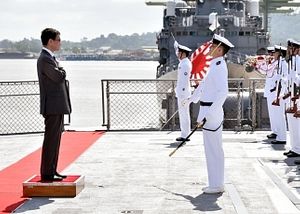This week, Japan launched the latest iteration of what is one of the newer manifestations of Tokyo’s security collaboration with Southeast Asian states. The third iteration of the Japan-ASEAN Ship Rider Program spotlighted Tokyo’s broader defense activities with regional states which have been an increasing focus in recent years.
While accounts of Japan’s role in Southeast Asia are often dominated by a focus on the economic realm, Tokyo has in fact long played an important security role as well. And as I have been noting in these pages, Tokyo has been expanding and accelerating its efforts to engage with ASEAN as a grouping on these issues in recent years. A case in point is Japan’s “Vientiane Vision,” initially announced in 2016 which is intended to develop the defense component of Tokyo’s relations with Southeast Asian states. The Vientiane Vision has also been incorporated into Japan’s own vision for the Indo-Pacific, a concept first publicly advanced by Prime Minister Shinzo Abe during his first stint as premier.
One of the manifestations of the Vientiane Vision has been the Japan-ASEAN Ship Rider Cooperation Program. The objective of the program, which was first held in June 2017, is to promote capacity-building for Southeast Asian states through various means, including seminars in areas such as international maritime law and humanitarian assistance and disaster relief as well as opportunities to witness training activities as well. In its previous iterations to date, the Ship Rider Cooperation Program has usually been launched amid other engagements with Southeast Asian states as well, including exercises.
This week, the pattern of annualization of the Japan-ASEAN Ship Rider Cooperation Program continued with the launch of its 2019 iteration. The 2019 iteration came as part of Indo-Pacific Deployment 2019 (IDP19) conducted by the Japan Maritime Self Defense Forces (JMSDF), which began in April 30 and lasts until July 10, includes five Southeast Asian countries – Brunei, Malaysia, the Philippines, Singapore, and Vietnam, and features several Japanese vessels including destroyers and carrier-based aircraft.
The 2019 program began on June 26 and lasts until June 30. Per Japan’s defense ministry, the location for the program is designated as being maritime areas close to Brunei and the Philippines, with some of those activities held on board the JS Izumo as well and the participants coming from ASEAN countries as well as the ASEAN Secretariat (to emphasize the multilateral bent of the engagement relative to other more bilateral ones).
With the engagement still ongoing, few details have been publicly disclosed about the exact activities and levels of participation. But in comments to local media outlets, the Commander of Japan’s flotilla of destroyers that had arrived in Brunei’s Muara Port for these activities, Hiroshi Egawa, cast these engagements as being part of realizing a “free and open Indo-Pacific” and made reference to the importance of stability, order, and freedom of navigation in the South China Sea.
Specifics will become clearer following the conclusion of the engagement, and it is important to reiterate that the Japan-ASEAN Ship Rider Cooperation Program is just one aspect of Tokyo’s engagement with Southeast Asian states in the defense realm. Nonetheless, monitoring the specific manifestations of Japan’s approach to the region will be important in continuing to assess how rhetoric is translating into reality.

































